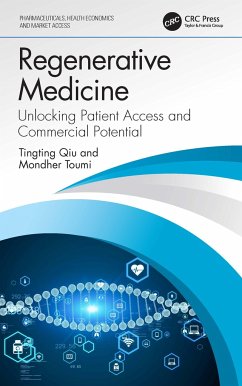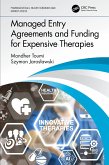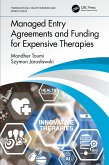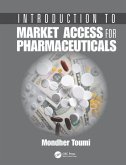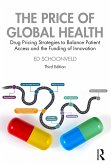- Broschiertes Buch
- Merkliste
- Auf die Merkliste
- Bewerten Bewerten
- Teilen
- Produkt teilen
- Produkterinnerung
- Produkterinnerung
A comprehensive review of the challenges that exist in patient accessibility to regenerative medicines (RMs), presenting clinical trials, marketing authorization, HTA, pricing, reimbursement, affordability, payment and partnership agreements of RMs and commercialization. Specfically, we investigated how COVID-19 has impacted the RM industry by elaborating on the disruptions it caused but also the new opportunities it brought. The ultimate goal of this work is to make strategic recommendations for manufacturers and decisions-makers on effective strategies to address the above obstacles and…mehr
Andere Kunden interessierten sich auch für
![Managed Entry Agreements and Funding for Expensive Therapies Managed Entry Agreements and Funding for Expensive Therapies]() Mondher ToumiManaged Entry Agreements and Funding for Expensive Therapies147,99 €
Mondher ToumiManaged Entry Agreements and Funding for Expensive Therapies147,99 €![Managed Entry Agreements and Funding for Expensive Therapies Managed Entry Agreements and Funding for Expensive Therapies]() Mondher ToumiManaged Entry Agreements and Funding for Expensive Therapies55,99 €
Mondher ToumiManaged Entry Agreements and Funding for Expensive Therapies55,99 €![Handbook of Cell and Gene Therapy Handbook of Cell and Gene Therapy]() Handbook of Cell and Gene Therapy137,99 €
Handbook of Cell and Gene Therapy137,99 €![Introduction to Market Access for Pharmaceuticals Introduction to Market Access for Pharmaceuticals]() Introduction to Market Access for Pharmaceuticals186,99 €
Introduction to Market Access for Pharmaceuticals186,99 €![Pharmacoeconomics Pharmacoeconomics]() Pharmacoeconomics49,99 €
Pharmacoeconomics49,99 €![The Price of Global Health The Price of Global Health]() Ed SchoonveldThe Price of Global Health183,99 €
Ed SchoonveldThe Price of Global Health183,99 €![Statistical Topics in Health Economics and Outcomes Research Statistical Topics in Health Economics and Outcomes Research]() Statistical Topics in Health Economics and Outcomes Research49,99 €
Statistical Topics in Health Economics and Outcomes Research49,99 €-
-
-
A comprehensive review of the challenges that exist in patient accessibility to regenerative medicines (RMs), presenting clinical trials, marketing authorization, HTA, pricing, reimbursement, affordability, payment and partnership agreements of RMs and commercialization. Specfically, we investigated how COVID-19 has impacted the RM industry by elaborating on the disruptions it caused but also the new opportunities it brought. The ultimate goal of this work is to make strategic recommendations for manufacturers and decisions-makers on effective strategies to address the above obstacles and facilitate patient access to promising regenerative medicines.
FEATURES
Regenerative medicine (RM) is an emerging interdisciplinary field aiming to replace or regenerate human cells, tissues, or organs in order to restore normal function.
RM holds the promise of revolutionizing treatment in the 21st century. RMs bring new hope for some previously untreatable diseases, as well as holding promise for the treatment of common chronic diseases. Rapid advancements in biotechnology and improved understanding of disease pathophysiology have attracted tremendous interests in the development of RMs. Discusses the high cost of RMs which may challenge the sustainability of healthcare insurers (public and private).
FEATURES
Regenerative medicine (RM) is an emerging interdisciplinary field aiming to replace or regenerate human cells, tissues, or organs in order to restore normal function.
RM holds the promise of revolutionizing treatment in the 21st century. RMs bring new hope for some previously untreatable diseases, as well as holding promise for the treatment of common chronic diseases. Rapid advancements in biotechnology and improved understanding of disease pathophysiology have attracted tremendous interests in the development of RMs. Discusses the high cost of RMs which may challenge the sustainability of healthcare insurers (public and private).
Produktdetails
- Produktdetails
- Pharmaceuticals, Health Economics and Market Access
- Verlag: CRC Press / Taylor & Francis
- Seitenzahl: 252
- Erscheinungstermin: 23. Mai 2023
- Englisch
- Abmessung: 229mm x 152mm x 14mm
- Gewicht: 340g
- ISBN-13: 9781032431987
- ISBN-10: 1032431989
- Artikelnr.: 67401741
- Herstellerkennzeichnung
- Libri GmbH
- Europaallee 1
- 36244 Bad Hersfeld
- gpsr@libri.de
- Pharmaceuticals, Health Economics and Market Access
- Verlag: CRC Press / Taylor & Francis
- Seitenzahl: 252
- Erscheinungstermin: 23. Mai 2023
- Englisch
- Abmessung: 229mm x 152mm x 14mm
- Gewicht: 340g
- ISBN-13: 9781032431987
- ISBN-10: 1032431989
- Artikelnr.: 67401741
- Herstellerkennzeichnung
- Libri GmbH
- Europaallee 1
- 36244 Bad Hersfeld
- gpsr@libri.de
Tingting Qiu holds a PhD degree in public health and a master's degree in pharmacology. Her area of expertise includes regulatory affairs, health policy, health technology assessment, economic analysis, and price and reimbursement of innovative therapies, such as orphan drugs and regenerative medicines. She has authored over 30 publications and conference presentations focused on the market access of cell and gene therapies at the European and global level. She worked as a price and market access analyst at Creativ-Ceutical (Paris, France) for 4 years from 2018, during which she was deeply involved in addressing the challenges in meeting the expectations of relevant stakeholders to facilitate the patient access to lifesaving treatments. Since 2021, she has been a research associate to EA 3279 CERESS Department of Public Health at Aix-Marseille University. Currently, she is a researcher in the Beijing Institute of Clinical Pharmacy, Beijing Friendship Hospital, Capital Medical University (Beijing, China). Apart from endeavoring to advance the market access of cell and gene therapies in China and globally, she is also engaged in projects focusing on the impact of implementing diagnosis-related groups reform on the healthcare system, the methodology of health economic analysis in China, and evidence-based assessment of Chinese and western medicines. Mondher Toumi is an MD by training and has an MSc in biostatistics and in biological sciences (option pharmacology) and a PhD in economic sciences. Toumi is a professor of public health at Aix-Marseille University. After working for 12 years as research manager in the Department of Pharmacology at the University of Marseille, he joined the Public Health Department in 1993. In 1995 he embraced a career in the pharmaceutical industry for 13 years. Toumi was appointed global vice president at Lundbeck A/S in charge of health economics, outcome research, pricing, market access, epidemiology, risk management, governmental affairs, and competitive intelligence. In 2008, he founded Creativ-Ceutical, an international consulting firm dedicated to support health industries and authorities in strategic decision-making. In February 2009 he was appointed professor at Lyon I University in the Department of Decision Sciences and Health Policies. The same year, he was appointed director of the Chair of Public Health and Market Access. He launched the first European University Diploma of Market Access (EMAUD), an international course already followed by almost 350 students. Additionally, he recently created the Market Access Society to promote education, research, and scientific activities at the interface of market access, HTA, public health, and health economic assessment. He is editor-in-chief of Journal of Market Access and Health Policy (JMAHP) which was just granted PubMed indexation. Toumi is also a visiting professor at Beijing University (Third Hospital). He is a recognized expert in health economics and an authority on market access and risk management. He has more than 250 scientific publications and communications and has contributed to several books.
Introduction
Chapter 1. Regulation of RMs in the global
1.1. Regulation of RMs in each country
1.1.1. European Union (EU)
1.1.2. United States
1.1.3. Japan
1.1.4. Australia
1.1.5. Canada
1.1.6. South Korea
1.1.7. China
1.1.8. Singapore
1.1.9. India
1.1.10. New Zealand
1.2. Comparisons between countries
1.2.1. International classification and definitions of RMs
1.2.2. RMs legislation and frameworks
1.2.3. International RMs market authorization procedures
1.2.4. Regulatory assessment considerations for RMs
1.2.5. Acceptance of alternative evidence generation
1.2.6. Expedited MA assessment programs for RMs
1.2.7. Accelerated approval programs for RMs
1.2.8. Post-market requirements for RMs approved
1.2.9. RMs sponsor incentives
1.3. Challenges and recommendations
1.3.1. Discrepancies between RM regulatory requirements
1.3.2. The significance of post-market evidence generation
1.3.3. Prospects and recommendations
1.4. Conclusion
Chapter 2. Health technology assessment of RMs
2.1. Country specific HTA decisions for individual products
2.1.1. Glybera® (Alipogene tiparvovec)
2.1.2. Kymriah® (Tisagenlecleucel)
2.1.3. Luxturna® (Voretigene neparvovec)
2.1.4. Imlygic® (Talimogene laherparepvec)
2.1.5. Strimvelis®
2.1.6. Yescarta® (Axicabtagene ciloleucel)
2.1.7. Zynteglo® (Betibeglogene autotemcel)
2.1.8. Libmeldy® (Atidarsagene autotemcel)
2.1.9. Zolgensma® (Onasemnogene abeparvovec)
2.1.10. Tecartus® (brexucabtagene autoleucel)
2.2. Summary of study limitation
2.2.1. Comparative study
2.2.2. Study population
2.2.3. Study endpoint
2.2.4. Statistical analysis
2.2.5. Confounding factors
2.2.6. Data transferability and generalizability
2.2.7. Indirect treatments comparison
2.3. Discussion and recommendations
2.3.1. Discrepancy in the Health Technology Assessment
2.3.2. Value Determination
2.3.3. Reimbursement and Affordability Strategies
2.3.4. Recommendations for clinical trials for RMs
Chapter 3. Challenges for market access of RMs
3.1. Introduction
3.2. Challenges in the Health Technology Assessment
3.2.1. Uncertainties in the Clinical Evidence
3.3. Challenges in Economic Analysis
3.3.1. Challenges in value assessment
3.4. Challenges in Pricing, Reimbursement and Affordability
3.4.1. Controversial Surrounding the High Price of RMs
3.4.2. High Up-Front Costs Threaten Existing Payment System
3.5. Challenges in Innovative Payment Strategies
3.5.1. Outcome-based payment
3.5.2. Annuity payment/instalment payment
3.6. Discussion and Recommendations
3.6.1. Summary of the Study Findings
3.6.2. Future Recommendations
3.7. Conclusion
Chapter 4. Impact of COVID-19 on the RMs industry
4.1. Introduction
4.2. Tremendous disruptions for all activities
4.2.1. Supply chain and manufacturing
4.2.2. Clinical trials
4.2.3. Delivering the therapies to patients
4.2.4. Small business
4.2.5. Regulatory activities
4.2.6. Health technology assessment
4.3. Progress made during the pandemic
4.3.1. New treatment opportunity
4.3.2. Financing raised
4.3.3. Regulation milestones
4.4. Conclusion
Chapter 5. Partnerships to expediate successful market access of RMs
5.1. Introduction
5.2. Overall description for the partnership for RMs
5.3. Key players of Partnership Agreements
5.4. Discussion
5.4.1. Overall Description
5.4.2. Types of Partnership Agreements
5.4.3. Future Trends and Strategies
5.5. Case analyses: partnerships for approved RMs
5.5.1. RMs commercialized on the market
5.5.2. RMs withdrew from the market
5.5.3. Summary
5.6. Conclusion
Chapter 6. Business models and commercial considerations for gene and cell therapies
6.1. Forecast of cell and gene therapy market
6.2. Increasing investment will bring fast-growing revenue
6.2.1. Cell and gene therapy market forecast for US
6.2.2. Cell and gene therapy market forecast for Europe
6.2.3. Cell and gene therapy market forecast for China
6.3. More challenges in the manufacturing and delivery
6.3.1. Challenges in manufacturing
6.3.2. Challenges in patient selection
6.3.3. Challenges in logistic and product delivery
6.3.4. Challenges in manufacturing allogeneic therapies
6.4. Why cell and gene therapies require a unique business model
6.4.1. Collaboration to navigate manufacturing challenges
6.4.2. Limited role of regional affiliates
6.4.3. Disruptions to traditional process of administration and monitoring
6.4.4. The time of approval is critical to secure market success
6.4.5. Different business strategies for cell and gene therapies
6.5. Partnerships to drive the CGT landscape progression
6.5.1. The advantage of partnership
6.5.2. Key cell and gene therapy participants
6.6. New payment models are needed for such innovative and costly therapies
6.6.1. The efficacy and safety of CGTs are not fully understood
6.6.2. Different value profiles for different patient population
6.6.3. High price of cell and gene therapies raised payment barriers
6.6.4. Innovative payment strategies to address payment challenges
6.6.5. Obstacles in implementing innovative payment strategies
6.7. Conclusions
Chapter 7. Summary of recommendations and perspective for future research
7.1. Summary of key findings
7.2. Recommendations for manufacturers
7.2.1. Partnerships to streamline the market access of RMs
7.2.2. Strategies to strengthen the quality of clinical evidence
7.2.3. Active engagements with other stakeholders
7.3. Implications for future research efforts
7.3.1. From the perspective of market authorization
7.3.2. From the perspective of HTA and affordability
References
Chapter 1. Regulation of RMs in the global
1.1. Regulation of RMs in each country
1.1.1. European Union (EU)
1.1.2. United States
1.1.3. Japan
1.1.4. Australia
1.1.5. Canada
1.1.6. South Korea
1.1.7. China
1.1.8. Singapore
1.1.9. India
1.1.10. New Zealand
1.2. Comparisons between countries
1.2.1. International classification and definitions of RMs
1.2.2. RMs legislation and frameworks
1.2.3. International RMs market authorization procedures
1.2.4. Regulatory assessment considerations for RMs
1.2.5. Acceptance of alternative evidence generation
1.2.6. Expedited MA assessment programs for RMs
1.2.7. Accelerated approval programs for RMs
1.2.8. Post-market requirements for RMs approved
1.2.9. RMs sponsor incentives
1.3. Challenges and recommendations
1.3.1. Discrepancies between RM regulatory requirements
1.3.2. The significance of post-market evidence generation
1.3.3. Prospects and recommendations
1.4. Conclusion
Chapter 2. Health technology assessment of RMs
2.1. Country specific HTA decisions for individual products
2.1.1. Glybera® (Alipogene tiparvovec)
2.1.2. Kymriah® (Tisagenlecleucel)
2.1.3. Luxturna® (Voretigene neparvovec)
2.1.4. Imlygic® (Talimogene laherparepvec)
2.1.5. Strimvelis®
2.1.6. Yescarta® (Axicabtagene ciloleucel)
2.1.7. Zynteglo® (Betibeglogene autotemcel)
2.1.8. Libmeldy® (Atidarsagene autotemcel)
2.1.9. Zolgensma® (Onasemnogene abeparvovec)
2.1.10. Tecartus® (brexucabtagene autoleucel)
2.2. Summary of study limitation
2.2.1. Comparative study
2.2.2. Study population
2.2.3. Study endpoint
2.2.4. Statistical analysis
2.2.5. Confounding factors
2.2.6. Data transferability and generalizability
2.2.7. Indirect treatments comparison
2.3. Discussion and recommendations
2.3.1. Discrepancy in the Health Technology Assessment
2.3.2. Value Determination
2.3.3. Reimbursement and Affordability Strategies
2.3.4. Recommendations for clinical trials for RMs
Chapter 3. Challenges for market access of RMs
3.1. Introduction
3.2. Challenges in the Health Technology Assessment
3.2.1. Uncertainties in the Clinical Evidence
3.3. Challenges in Economic Analysis
3.3.1. Challenges in value assessment
3.4. Challenges in Pricing, Reimbursement and Affordability
3.4.1. Controversial Surrounding the High Price of RMs
3.4.2. High Up-Front Costs Threaten Existing Payment System
3.5. Challenges in Innovative Payment Strategies
3.5.1. Outcome-based payment
3.5.2. Annuity payment/instalment payment
3.6. Discussion and Recommendations
3.6.1. Summary of the Study Findings
3.6.2. Future Recommendations
3.7. Conclusion
Chapter 4. Impact of COVID-19 on the RMs industry
4.1. Introduction
4.2. Tremendous disruptions for all activities
4.2.1. Supply chain and manufacturing
4.2.2. Clinical trials
4.2.3. Delivering the therapies to patients
4.2.4. Small business
4.2.5. Regulatory activities
4.2.6. Health technology assessment
4.3. Progress made during the pandemic
4.3.1. New treatment opportunity
4.3.2. Financing raised
4.3.3. Regulation milestones
4.4. Conclusion
Chapter 5. Partnerships to expediate successful market access of RMs
5.1. Introduction
5.2. Overall description for the partnership for RMs
5.3. Key players of Partnership Agreements
5.4. Discussion
5.4.1. Overall Description
5.4.2. Types of Partnership Agreements
5.4.3. Future Trends and Strategies
5.5. Case analyses: partnerships for approved RMs
5.5.1. RMs commercialized on the market
5.5.2. RMs withdrew from the market
5.5.3. Summary
5.6. Conclusion
Chapter 6. Business models and commercial considerations for gene and cell therapies
6.1. Forecast of cell and gene therapy market
6.2. Increasing investment will bring fast-growing revenue
6.2.1. Cell and gene therapy market forecast for US
6.2.2. Cell and gene therapy market forecast for Europe
6.2.3. Cell and gene therapy market forecast for China
6.3. More challenges in the manufacturing and delivery
6.3.1. Challenges in manufacturing
6.3.2. Challenges in patient selection
6.3.3. Challenges in logistic and product delivery
6.3.4. Challenges in manufacturing allogeneic therapies
6.4. Why cell and gene therapies require a unique business model
6.4.1. Collaboration to navigate manufacturing challenges
6.4.2. Limited role of regional affiliates
6.4.3. Disruptions to traditional process of administration and monitoring
6.4.4. The time of approval is critical to secure market success
6.4.5. Different business strategies for cell and gene therapies
6.5. Partnerships to drive the CGT landscape progression
6.5.1. The advantage of partnership
6.5.2. Key cell and gene therapy participants
6.6. New payment models are needed for such innovative and costly therapies
6.6.1. The efficacy and safety of CGTs are not fully understood
6.6.2. Different value profiles for different patient population
6.6.3. High price of cell and gene therapies raised payment barriers
6.6.4. Innovative payment strategies to address payment challenges
6.6.5. Obstacles in implementing innovative payment strategies
6.7. Conclusions
Chapter 7. Summary of recommendations and perspective for future research
7.1. Summary of key findings
7.2. Recommendations for manufacturers
7.2.1. Partnerships to streamline the market access of RMs
7.2.2. Strategies to strengthen the quality of clinical evidence
7.2.3. Active engagements with other stakeholders
7.3. Implications for future research efforts
7.3.1. From the perspective of market authorization
7.3.2. From the perspective of HTA and affordability
References
Introduction
Chapter 1. Regulation of RMs in the global
1.1. Regulation of RMs in each country
1.1.1. European Union (EU)
1.1.2. United States
1.1.3. Japan
1.1.4. Australia
1.1.5. Canada
1.1.6. South Korea
1.1.7. China
1.1.8. Singapore
1.1.9. India
1.1.10. New Zealand
1.2. Comparisons between countries
1.2.1. International classification and definitions of RMs
1.2.2. RMs legislation and frameworks
1.2.3. International RMs market authorization procedures
1.2.4. Regulatory assessment considerations for RMs
1.2.5. Acceptance of alternative evidence generation
1.2.6. Expedited MA assessment programs for RMs
1.2.7. Accelerated approval programs for RMs
1.2.8. Post-market requirements for RMs approved
1.2.9. RMs sponsor incentives
1.3. Challenges and recommendations
1.3.1. Discrepancies between RM regulatory requirements
1.3.2. The significance of post-market evidence generation
1.3.3. Prospects and recommendations
1.4. Conclusion
Chapter 2. Health technology assessment of RMs
2.1. Country specific HTA decisions for individual products
2.1.1. Glybera® (Alipogene tiparvovec)
2.1.2. Kymriah® (Tisagenlecleucel)
2.1.3. Luxturna® (Voretigene neparvovec)
2.1.4. Imlygic® (Talimogene laherparepvec)
2.1.5. Strimvelis®
2.1.6. Yescarta® (Axicabtagene ciloleucel)
2.1.7. Zynteglo® (Betibeglogene autotemcel)
2.1.8. Libmeldy® (Atidarsagene autotemcel)
2.1.9. Zolgensma® (Onasemnogene abeparvovec)
2.1.10. Tecartus® (brexucabtagene autoleucel)
2.2. Summary of study limitation
2.2.1. Comparative study
2.2.2. Study population
2.2.3. Study endpoint
2.2.4. Statistical analysis
2.2.5. Confounding factors
2.2.6. Data transferability and generalizability
2.2.7. Indirect treatments comparison
2.3. Discussion and recommendations
2.3.1. Discrepancy in the Health Technology Assessment
2.3.2. Value Determination
2.3.3. Reimbursement and Affordability Strategies
2.3.4. Recommendations for clinical trials for RMs
Chapter 3. Challenges for market access of RMs
3.1. Introduction
3.2. Challenges in the Health Technology Assessment
3.2.1. Uncertainties in the Clinical Evidence
3.3. Challenges in Economic Analysis
3.3.1. Challenges in value assessment
3.4. Challenges in Pricing, Reimbursement and Affordability
3.4.1. Controversial Surrounding the High Price of RMs
3.4.2. High Up-Front Costs Threaten Existing Payment System
3.5. Challenges in Innovative Payment Strategies
3.5.1. Outcome-based payment
3.5.2. Annuity payment/instalment payment
3.6. Discussion and Recommendations
3.6.1. Summary of the Study Findings
3.6.2. Future Recommendations
3.7. Conclusion
Chapter 4. Impact of COVID-19 on the RMs industry
4.1. Introduction
4.2. Tremendous disruptions for all activities
4.2.1. Supply chain and manufacturing
4.2.2. Clinical trials
4.2.3. Delivering the therapies to patients
4.2.4. Small business
4.2.5. Regulatory activities
4.2.6. Health technology assessment
4.3. Progress made during the pandemic
4.3.1. New treatment opportunity
4.3.2. Financing raised
4.3.3. Regulation milestones
4.4. Conclusion
Chapter 5. Partnerships to expediate successful market access of RMs
5.1. Introduction
5.2. Overall description for the partnership for RMs
5.3. Key players of Partnership Agreements
5.4. Discussion
5.4.1. Overall Description
5.4.2. Types of Partnership Agreements
5.4.3. Future Trends and Strategies
5.5. Case analyses: partnerships for approved RMs
5.5.1. RMs commercialized on the market
5.5.2. RMs withdrew from the market
5.5.3. Summary
5.6. Conclusion
Chapter 6. Business models and commercial considerations for gene and cell
therapies
6.1. Forecast of cell and gene therapy market
6.2. Increasing investment will bring fast-growing revenue
6.2.1. Cell and gene therapy market forecast for US
6.2.2. Cell and gene therapy market forecast for Europe
6.2.3. Cell and gene therapy market forecast for China
6.3. More challenges in the manufacturing and delivery
6.3.1. Challenges in manufacturing
6.3.2. Challenges in patient selection
6.3.3. Challenges in logistic and product delivery
6.3.4. Challenges in manufacturing allogeneic therapies
6.4. Why cell and gene therapies require a unique business model
6.4.1. Collaboration to navigate manufacturing challenges
6.4.2. Limited role of regional affiliates
6.4.3. Disruptions to traditional process of administration and monitoring
6.4.4. The time of approval is critical to secure market success
6.4.5. Different business strategies for cell and gene therapies
6.5. Partnerships to drive the CGT landscape progression
6.5.1. The advantage of partnership
6.5.2. Key cell and gene therapy participants
6.6. New payment models are needed for such innovative and costly therapies
6.6.1. The efficacy and safety of CGTs are not fully understood
6.6.2. Different value profiles for different patient population
6.6.3. High price of cell and gene therapies raised payment barriers
6.6.4. Innovative payment strategies to address payment challenges
6.6.5. Obstacles in implementing innovative payment strategies
6.7. Conclusions
Chapter 7. Summary of recommendations and perspective for future research
7.1. Summary of key findings
7.2. Recommendations for manufacturers
7.2.1. Partnerships to streamline the market access of RMs
7.2.2. Strategies to strengthen the quality of clinical evidence
7.2.3. Active engagements with other stakeholders
7.3. Implications for future research efforts
7.3.1. From the perspective of market authorization
7.3.2. From the perspective of HTA and affordability
References
Chapter 1. Regulation of RMs in the global
1.1. Regulation of RMs in each country
1.1.1. European Union (EU)
1.1.2. United States
1.1.3. Japan
1.1.4. Australia
1.1.5. Canada
1.1.6. South Korea
1.1.7. China
1.1.8. Singapore
1.1.9. India
1.1.10. New Zealand
1.2. Comparisons between countries
1.2.1. International classification and definitions of RMs
1.2.2. RMs legislation and frameworks
1.2.3. International RMs market authorization procedures
1.2.4. Regulatory assessment considerations for RMs
1.2.5. Acceptance of alternative evidence generation
1.2.6. Expedited MA assessment programs for RMs
1.2.7. Accelerated approval programs for RMs
1.2.8. Post-market requirements for RMs approved
1.2.9. RMs sponsor incentives
1.3. Challenges and recommendations
1.3.1. Discrepancies between RM regulatory requirements
1.3.2. The significance of post-market evidence generation
1.3.3. Prospects and recommendations
1.4. Conclusion
Chapter 2. Health technology assessment of RMs
2.1. Country specific HTA decisions for individual products
2.1.1. Glybera® (Alipogene tiparvovec)
2.1.2. Kymriah® (Tisagenlecleucel)
2.1.3. Luxturna® (Voretigene neparvovec)
2.1.4. Imlygic® (Talimogene laherparepvec)
2.1.5. Strimvelis®
2.1.6. Yescarta® (Axicabtagene ciloleucel)
2.1.7. Zynteglo® (Betibeglogene autotemcel)
2.1.8. Libmeldy® (Atidarsagene autotemcel)
2.1.9. Zolgensma® (Onasemnogene abeparvovec)
2.1.10. Tecartus® (brexucabtagene autoleucel)
2.2. Summary of study limitation
2.2.1. Comparative study
2.2.2. Study population
2.2.3. Study endpoint
2.2.4. Statistical analysis
2.2.5. Confounding factors
2.2.6. Data transferability and generalizability
2.2.7. Indirect treatments comparison
2.3. Discussion and recommendations
2.3.1. Discrepancy in the Health Technology Assessment
2.3.2. Value Determination
2.3.3. Reimbursement and Affordability Strategies
2.3.4. Recommendations for clinical trials for RMs
Chapter 3. Challenges for market access of RMs
3.1. Introduction
3.2. Challenges in the Health Technology Assessment
3.2.1. Uncertainties in the Clinical Evidence
3.3. Challenges in Economic Analysis
3.3.1. Challenges in value assessment
3.4. Challenges in Pricing, Reimbursement and Affordability
3.4.1. Controversial Surrounding the High Price of RMs
3.4.2. High Up-Front Costs Threaten Existing Payment System
3.5. Challenges in Innovative Payment Strategies
3.5.1. Outcome-based payment
3.5.2. Annuity payment/instalment payment
3.6. Discussion and Recommendations
3.6.1. Summary of the Study Findings
3.6.2. Future Recommendations
3.7. Conclusion
Chapter 4. Impact of COVID-19 on the RMs industry
4.1. Introduction
4.2. Tremendous disruptions for all activities
4.2.1. Supply chain and manufacturing
4.2.2. Clinical trials
4.2.3. Delivering the therapies to patients
4.2.4. Small business
4.2.5. Regulatory activities
4.2.6. Health technology assessment
4.3. Progress made during the pandemic
4.3.1. New treatment opportunity
4.3.2. Financing raised
4.3.3. Regulation milestones
4.4. Conclusion
Chapter 5. Partnerships to expediate successful market access of RMs
5.1. Introduction
5.2. Overall description for the partnership for RMs
5.3. Key players of Partnership Agreements
5.4. Discussion
5.4.1. Overall Description
5.4.2. Types of Partnership Agreements
5.4.3. Future Trends and Strategies
5.5. Case analyses: partnerships for approved RMs
5.5.1. RMs commercialized on the market
5.5.2. RMs withdrew from the market
5.5.3. Summary
5.6. Conclusion
Chapter 6. Business models and commercial considerations for gene and cell
therapies
6.1. Forecast of cell and gene therapy market
6.2. Increasing investment will bring fast-growing revenue
6.2.1. Cell and gene therapy market forecast for US
6.2.2. Cell and gene therapy market forecast for Europe
6.2.3. Cell and gene therapy market forecast for China
6.3. More challenges in the manufacturing and delivery
6.3.1. Challenges in manufacturing
6.3.2. Challenges in patient selection
6.3.3. Challenges in logistic and product delivery
6.3.4. Challenges in manufacturing allogeneic therapies
6.4. Why cell and gene therapies require a unique business model
6.4.1. Collaboration to navigate manufacturing challenges
6.4.2. Limited role of regional affiliates
6.4.3. Disruptions to traditional process of administration and monitoring
6.4.4. The time of approval is critical to secure market success
6.4.5. Different business strategies for cell and gene therapies
6.5. Partnerships to drive the CGT landscape progression
6.5.1. The advantage of partnership
6.5.2. Key cell and gene therapy participants
6.6. New payment models are needed for such innovative and costly therapies
6.6.1. The efficacy and safety of CGTs are not fully understood
6.6.2. Different value profiles for different patient population
6.6.3. High price of cell and gene therapies raised payment barriers
6.6.4. Innovative payment strategies to address payment challenges
6.6.5. Obstacles in implementing innovative payment strategies
6.7. Conclusions
Chapter 7. Summary of recommendations and perspective for future research
7.1. Summary of key findings
7.2. Recommendations for manufacturers
7.2.1. Partnerships to streamline the market access of RMs
7.2.2. Strategies to strengthen the quality of clinical evidence
7.2.3. Active engagements with other stakeholders
7.3. Implications for future research efforts
7.3.1. From the perspective of market authorization
7.3.2. From the perspective of HTA and affordability
References
Introduction
Chapter 1. Regulation of RMs in the global
1.1. Regulation of RMs in each country
1.1.1. European Union (EU)
1.1.2. United States
1.1.3. Japan
1.1.4. Australia
1.1.5. Canada
1.1.6. South Korea
1.1.7. China
1.1.8. Singapore
1.1.9. India
1.1.10. New Zealand
1.2. Comparisons between countries
1.2.1. International classification and definitions of RMs
1.2.2. RMs legislation and frameworks
1.2.3. International RMs market authorization procedures
1.2.4. Regulatory assessment considerations for RMs
1.2.5. Acceptance of alternative evidence generation
1.2.6. Expedited MA assessment programs for RMs
1.2.7. Accelerated approval programs for RMs
1.2.8. Post-market requirements for RMs approved
1.2.9. RMs sponsor incentives
1.3. Challenges and recommendations
1.3.1. Discrepancies between RM regulatory requirements
1.3.2. The significance of post-market evidence generation
1.3.3. Prospects and recommendations
1.4. Conclusion
Chapter 2. Health technology assessment of RMs
2.1. Country specific HTA decisions for individual products
2.1.1. Glybera® (Alipogene tiparvovec)
2.1.2. Kymriah® (Tisagenlecleucel)
2.1.3. Luxturna® (Voretigene neparvovec)
2.1.4. Imlygic® (Talimogene laherparepvec)
2.1.5. Strimvelis®
2.1.6. Yescarta® (Axicabtagene ciloleucel)
2.1.7. Zynteglo® (Betibeglogene autotemcel)
2.1.8. Libmeldy® (Atidarsagene autotemcel)
2.1.9. Zolgensma® (Onasemnogene abeparvovec)
2.1.10. Tecartus® (brexucabtagene autoleucel)
2.2. Summary of study limitation
2.2.1. Comparative study
2.2.2. Study population
2.2.3. Study endpoint
2.2.4. Statistical analysis
2.2.5. Confounding factors
2.2.6. Data transferability and generalizability
2.2.7. Indirect treatments comparison
2.3. Discussion and recommendations
2.3.1. Discrepancy in the Health Technology Assessment
2.3.2. Value Determination
2.3.3. Reimbursement and Affordability Strategies
2.3.4. Recommendations for clinical trials for RMs
Chapter 3. Challenges for market access of RMs
3.1. Introduction
3.2. Challenges in the Health Technology Assessment
3.2.1. Uncertainties in the Clinical Evidence
3.3. Challenges in Economic Analysis
3.3.1. Challenges in value assessment
3.4. Challenges in Pricing, Reimbursement and Affordability
3.4.1. Controversial Surrounding the High Price of RMs
3.4.2. High Up-Front Costs Threaten Existing Payment System
3.5. Challenges in Innovative Payment Strategies
3.5.1. Outcome-based payment
3.5.2. Annuity payment/instalment payment
3.6. Discussion and Recommendations
3.6.1. Summary of the Study Findings
3.6.2. Future Recommendations
3.7. Conclusion
Chapter 4. Impact of COVID-19 on the RMs industry
4.1. Introduction
4.2. Tremendous disruptions for all activities
4.2.1. Supply chain and manufacturing
4.2.2. Clinical trials
4.2.3. Delivering the therapies to patients
4.2.4. Small business
4.2.5. Regulatory activities
4.2.6. Health technology assessment
4.3. Progress made during the pandemic
4.3.1. New treatment opportunity
4.3.2. Financing raised
4.3.3. Regulation milestones
4.4. Conclusion
Chapter 5. Partnerships to expediate successful market access of RMs
5.1. Introduction
5.2. Overall description for the partnership for RMs
5.3. Key players of Partnership Agreements
5.4. Discussion
5.4.1. Overall Description
5.4.2. Types of Partnership Agreements
5.4.3. Future Trends and Strategies
5.5. Case analyses: partnerships for approved RMs
5.5.1. RMs commercialized on the market
5.5.2. RMs withdrew from the market
5.5.3. Summary
5.6. Conclusion
Chapter 6. Business models and commercial considerations for gene and cell therapies
6.1. Forecast of cell and gene therapy market
6.2. Increasing investment will bring fast-growing revenue
6.2.1. Cell and gene therapy market forecast for US
6.2.2. Cell and gene therapy market forecast for Europe
6.2.3. Cell and gene therapy market forecast for China
6.3. More challenges in the manufacturing and delivery
6.3.1. Challenges in manufacturing
6.3.2. Challenges in patient selection
6.3.3. Challenges in logistic and product delivery
6.3.4. Challenges in manufacturing allogeneic therapies
6.4. Why cell and gene therapies require a unique business model
6.4.1. Collaboration to navigate manufacturing challenges
6.4.2. Limited role of regional affiliates
6.4.3. Disruptions to traditional process of administration and monitoring
6.4.4. The time of approval is critical to secure market success
6.4.5. Different business strategies for cell and gene therapies
6.5. Partnerships to drive the CGT landscape progression
6.5.1. The advantage of partnership
6.5.2. Key cell and gene therapy participants
6.6. New payment models are needed for such innovative and costly therapies
6.6.1. The efficacy and safety of CGTs are not fully understood
6.6.2. Different value profiles for different patient population
6.6.3. High price of cell and gene therapies raised payment barriers
6.6.4. Innovative payment strategies to address payment challenges
6.6.5. Obstacles in implementing innovative payment strategies
6.7. Conclusions
Chapter 7. Summary of recommendations and perspective for future research
7.1. Summary of key findings
7.2. Recommendations for manufacturers
7.2.1. Partnerships to streamline the market access of RMs
7.2.2. Strategies to strengthen the quality of clinical evidence
7.2.3. Active engagements with other stakeholders
7.3. Implications for future research efforts
7.3.1. From the perspective of market authorization
7.3.2. From the perspective of HTA and affordability
References
Chapter 1. Regulation of RMs in the global
1.1. Regulation of RMs in each country
1.1.1. European Union (EU)
1.1.2. United States
1.1.3. Japan
1.1.4. Australia
1.1.5. Canada
1.1.6. South Korea
1.1.7. China
1.1.8. Singapore
1.1.9. India
1.1.10. New Zealand
1.2. Comparisons between countries
1.2.1. International classification and definitions of RMs
1.2.2. RMs legislation and frameworks
1.2.3. International RMs market authorization procedures
1.2.4. Regulatory assessment considerations for RMs
1.2.5. Acceptance of alternative evidence generation
1.2.6. Expedited MA assessment programs for RMs
1.2.7. Accelerated approval programs for RMs
1.2.8. Post-market requirements for RMs approved
1.2.9. RMs sponsor incentives
1.3. Challenges and recommendations
1.3.1. Discrepancies between RM regulatory requirements
1.3.2. The significance of post-market evidence generation
1.3.3. Prospects and recommendations
1.4. Conclusion
Chapter 2. Health technology assessment of RMs
2.1. Country specific HTA decisions for individual products
2.1.1. Glybera® (Alipogene tiparvovec)
2.1.2. Kymriah® (Tisagenlecleucel)
2.1.3. Luxturna® (Voretigene neparvovec)
2.1.4. Imlygic® (Talimogene laherparepvec)
2.1.5. Strimvelis®
2.1.6. Yescarta® (Axicabtagene ciloleucel)
2.1.7. Zynteglo® (Betibeglogene autotemcel)
2.1.8. Libmeldy® (Atidarsagene autotemcel)
2.1.9. Zolgensma® (Onasemnogene abeparvovec)
2.1.10. Tecartus® (brexucabtagene autoleucel)
2.2. Summary of study limitation
2.2.1. Comparative study
2.2.2. Study population
2.2.3. Study endpoint
2.2.4. Statistical analysis
2.2.5. Confounding factors
2.2.6. Data transferability and generalizability
2.2.7. Indirect treatments comparison
2.3. Discussion and recommendations
2.3.1. Discrepancy in the Health Technology Assessment
2.3.2. Value Determination
2.3.3. Reimbursement and Affordability Strategies
2.3.4. Recommendations for clinical trials for RMs
Chapter 3. Challenges for market access of RMs
3.1. Introduction
3.2. Challenges in the Health Technology Assessment
3.2.1. Uncertainties in the Clinical Evidence
3.3. Challenges in Economic Analysis
3.3.1. Challenges in value assessment
3.4. Challenges in Pricing, Reimbursement and Affordability
3.4.1. Controversial Surrounding the High Price of RMs
3.4.2. High Up-Front Costs Threaten Existing Payment System
3.5. Challenges in Innovative Payment Strategies
3.5.1. Outcome-based payment
3.5.2. Annuity payment/instalment payment
3.6. Discussion and Recommendations
3.6.1. Summary of the Study Findings
3.6.2. Future Recommendations
3.7. Conclusion
Chapter 4. Impact of COVID-19 on the RMs industry
4.1. Introduction
4.2. Tremendous disruptions for all activities
4.2.1. Supply chain and manufacturing
4.2.2. Clinical trials
4.2.3. Delivering the therapies to patients
4.2.4. Small business
4.2.5. Regulatory activities
4.2.6. Health technology assessment
4.3. Progress made during the pandemic
4.3.1. New treatment opportunity
4.3.2. Financing raised
4.3.3. Regulation milestones
4.4. Conclusion
Chapter 5. Partnerships to expediate successful market access of RMs
5.1. Introduction
5.2. Overall description for the partnership for RMs
5.3. Key players of Partnership Agreements
5.4. Discussion
5.4.1. Overall Description
5.4.2. Types of Partnership Agreements
5.4.3. Future Trends and Strategies
5.5. Case analyses: partnerships for approved RMs
5.5.1. RMs commercialized on the market
5.5.2. RMs withdrew from the market
5.5.3. Summary
5.6. Conclusion
Chapter 6. Business models and commercial considerations for gene and cell therapies
6.1. Forecast of cell and gene therapy market
6.2. Increasing investment will bring fast-growing revenue
6.2.1. Cell and gene therapy market forecast for US
6.2.2. Cell and gene therapy market forecast for Europe
6.2.3. Cell and gene therapy market forecast for China
6.3. More challenges in the manufacturing and delivery
6.3.1. Challenges in manufacturing
6.3.2. Challenges in patient selection
6.3.3. Challenges in logistic and product delivery
6.3.4. Challenges in manufacturing allogeneic therapies
6.4. Why cell and gene therapies require a unique business model
6.4.1. Collaboration to navigate manufacturing challenges
6.4.2. Limited role of regional affiliates
6.4.3. Disruptions to traditional process of administration and monitoring
6.4.4. The time of approval is critical to secure market success
6.4.5. Different business strategies for cell and gene therapies
6.5. Partnerships to drive the CGT landscape progression
6.5.1. The advantage of partnership
6.5.2. Key cell and gene therapy participants
6.6. New payment models are needed for such innovative and costly therapies
6.6.1. The efficacy and safety of CGTs are not fully understood
6.6.2. Different value profiles for different patient population
6.6.3. High price of cell and gene therapies raised payment barriers
6.6.4. Innovative payment strategies to address payment challenges
6.6.5. Obstacles in implementing innovative payment strategies
6.7. Conclusions
Chapter 7. Summary of recommendations and perspective for future research
7.1. Summary of key findings
7.2. Recommendations for manufacturers
7.2.1. Partnerships to streamline the market access of RMs
7.2.2. Strategies to strengthen the quality of clinical evidence
7.2.3. Active engagements with other stakeholders
7.3. Implications for future research efforts
7.3.1. From the perspective of market authorization
7.3.2. From the perspective of HTA and affordability
References
Introduction
Chapter 1. Regulation of RMs in the global
1.1. Regulation of RMs in each country
1.1.1. European Union (EU)
1.1.2. United States
1.1.3. Japan
1.1.4. Australia
1.1.5. Canada
1.1.6. South Korea
1.1.7. China
1.1.8. Singapore
1.1.9. India
1.1.10. New Zealand
1.2. Comparisons between countries
1.2.1. International classification and definitions of RMs
1.2.2. RMs legislation and frameworks
1.2.3. International RMs market authorization procedures
1.2.4. Regulatory assessment considerations for RMs
1.2.5. Acceptance of alternative evidence generation
1.2.6. Expedited MA assessment programs for RMs
1.2.7. Accelerated approval programs for RMs
1.2.8. Post-market requirements for RMs approved
1.2.9. RMs sponsor incentives
1.3. Challenges and recommendations
1.3.1. Discrepancies between RM regulatory requirements
1.3.2. The significance of post-market evidence generation
1.3.3. Prospects and recommendations
1.4. Conclusion
Chapter 2. Health technology assessment of RMs
2.1. Country specific HTA decisions for individual products
2.1.1. Glybera® (Alipogene tiparvovec)
2.1.2. Kymriah® (Tisagenlecleucel)
2.1.3. Luxturna® (Voretigene neparvovec)
2.1.4. Imlygic® (Talimogene laherparepvec)
2.1.5. Strimvelis®
2.1.6. Yescarta® (Axicabtagene ciloleucel)
2.1.7. Zynteglo® (Betibeglogene autotemcel)
2.1.8. Libmeldy® (Atidarsagene autotemcel)
2.1.9. Zolgensma® (Onasemnogene abeparvovec)
2.1.10. Tecartus® (brexucabtagene autoleucel)
2.2. Summary of study limitation
2.2.1. Comparative study
2.2.2. Study population
2.2.3. Study endpoint
2.2.4. Statistical analysis
2.2.5. Confounding factors
2.2.6. Data transferability and generalizability
2.2.7. Indirect treatments comparison
2.3. Discussion and recommendations
2.3.1. Discrepancy in the Health Technology Assessment
2.3.2. Value Determination
2.3.3. Reimbursement and Affordability Strategies
2.3.4. Recommendations for clinical trials for RMs
Chapter 3. Challenges for market access of RMs
3.1. Introduction
3.2. Challenges in the Health Technology Assessment
3.2.1. Uncertainties in the Clinical Evidence
3.3. Challenges in Economic Analysis
3.3.1. Challenges in value assessment
3.4. Challenges in Pricing, Reimbursement and Affordability
3.4.1. Controversial Surrounding the High Price of RMs
3.4.2. High Up-Front Costs Threaten Existing Payment System
3.5. Challenges in Innovative Payment Strategies
3.5.1. Outcome-based payment
3.5.2. Annuity payment/instalment payment
3.6. Discussion and Recommendations
3.6.1. Summary of the Study Findings
3.6.2. Future Recommendations
3.7. Conclusion
Chapter 4. Impact of COVID-19 on the RMs industry
4.1. Introduction
4.2. Tremendous disruptions for all activities
4.2.1. Supply chain and manufacturing
4.2.2. Clinical trials
4.2.3. Delivering the therapies to patients
4.2.4. Small business
4.2.5. Regulatory activities
4.2.6. Health technology assessment
4.3. Progress made during the pandemic
4.3.1. New treatment opportunity
4.3.2. Financing raised
4.3.3. Regulation milestones
4.4. Conclusion
Chapter 5. Partnerships to expediate successful market access of RMs
5.1. Introduction
5.2. Overall description for the partnership for RMs
5.3. Key players of Partnership Agreements
5.4. Discussion
5.4.1. Overall Description
5.4.2. Types of Partnership Agreements
5.4.3. Future Trends and Strategies
5.5. Case analyses: partnerships for approved RMs
5.5.1. RMs commercialized on the market
5.5.2. RMs withdrew from the market
5.5.3. Summary
5.6. Conclusion
Chapter 6. Business models and commercial considerations for gene and cell
therapies
6.1. Forecast of cell and gene therapy market
6.2. Increasing investment will bring fast-growing revenue
6.2.1. Cell and gene therapy market forecast for US
6.2.2. Cell and gene therapy market forecast for Europe
6.2.3. Cell and gene therapy market forecast for China
6.3. More challenges in the manufacturing and delivery
6.3.1. Challenges in manufacturing
6.3.2. Challenges in patient selection
6.3.3. Challenges in logistic and product delivery
6.3.4. Challenges in manufacturing allogeneic therapies
6.4. Why cell and gene therapies require a unique business model
6.4.1. Collaboration to navigate manufacturing challenges
6.4.2. Limited role of regional affiliates
6.4.3. Disruptions to traditional process of administration and monitoring
6.4.4. The time of approval is critical to secure market success
6.4.5. Different business strategies for cell and gene therapies
6.5. Partnerships to drive the CGT landscape progression
6.5.1. The advantage of partnership
6.5.2. Key cell and gene therapy participants
6.6. New payment models are needed for such innovative and costly therapies
6.6.1. The efficacy and safety of CGTs are not fully understood
6.6.2. Different value profiles for different patient population
6.6.3. High price of cell and gene therapies raised payment barriers
6.6.4. Innovative payment strategies to address payment challenges
6.6.5. Obstacles in implementing innovative payment strategies
6.7. Conclusions
Chapter 7. Summary of recommendations and perspective for future research
7.1. Summary of key findings
7.2. Recommendations for manufacturers
7.2.1. Partnerships to streamline the market access of RMs
7.2.2. Strategies to strengthen the quality of clinical evidence
7.2.3. Active engagements with other stakeholders
7.3. Implications for future research efforts
7.3.1. From the perspective of market authorization
7.3.2. From the perspective of HTA and affordability
References
Chapter 1. Regulation of RMs in the global
1.1. Regulation of RMs in each country
1.1.1. European Union (EU)
1.1.2. United States
1.1.3. Japan
1.1.4. Australia
1.1.5. Canada
1.1.6. South Korea
1.1.7. China
1.1.8. Singapore
1.1.9. India
1.1.10. New Zealand
1.2. Comparisons between countries
1.2.1. International classification and definitions of RMs
1.2.2. RMs legislation and frameworks
1.2.3. International RMs market authorization procedures
1.2.4. Regulatory assessment considerations for RMs
1.2.5. Acceptance of alternative evidence generation
1.2.6. Expedited MA assessment programs for RMs
1.2.7. Accelerated approval programs for RMs
1.2.8. Post-market requirements for RMs approved
1.2.9. RMs sponsor incentives
1.3. Challenges and recommendations
1.3.1. Discrepancies between RM regulatory requirements
1.3.2. The significance of post-market evidence generation
1.3.3. Prospects and recommendations
1.4. Conclusion
Chapter 2. Health technology assessment of RMs
2.1. Country specific HTA decisions for individual products
2.1.1. Glybera® (Alipogene tiparvovec)
2.1.2. Kymriah® (Tisagenlecleucel)
2.1.3. Luxturna® (Voretigene neparvovec)
2.1.4. Imlygic® (Talimogene laherparepvec)
2.1.5. Strimvelis®
2.1.6. Yescarta® (Axicabtagene ciloleucel)
2.1.7. Zynteglo® (Betibeglogene autotemcel)
2.1.8. Libmeldy® (Atidarsagene autotemcel)
2.1.9. Zolgensma® (Onasemnogene abeparvovec)
2.1.10. Tecartus® (brexucabtagene autoleucel)
2.2. Summary of study limitation
2.2.1. Comparative study
2.2.2. Study population
2.2.3. Study endpoint
2.2.4. Statistical analysis
2.2.5. Confounding factors
2.2.6. Data transferability and generalizability
2.2.7. Indirect treatments comparison
2.3. Discussion and recommendations
2.3.1. Discrepancy in the Health Technology Assessment
2.3.2. Value Determination
2.3.3. Reimbursement and Affordability Strategies
2.3.4. Recommendations for clinical trials for RMs
Chapter 3. Challenges for market access of RMs
3.1. Introduction
3.2. Challenges in the Health Technology Assessment
3.2.1. Uncertainties in the Clinical Evidence
3.3. Challenges in Economic Analysis
3.3.1. Challenges in value assessment
3.4. Challenges in Pricing, Reimbursement and Affordability
3.4.1. Controversial Surrounding the High Price of RMs
3.4.2. High Up-Front Costs Threaten Existing Payment System
3.5. Challenges in Innovative Payment Strategies
3.5.1. Outcome-based payment
3.5.2. Annuity payment/instalment payment
3.6. Discussion and Recommendations
3.6.1. Summary of the Study Findings
3.6.2. Future Recommendations
3.7. Conclusion
Chapter 4. Impact of COVID-19 on the RMs industry
4.1. Introduction
4.2. Tremendous disruptions for all activities
4.2.1. Supply chain and manufacturing
4.2.2. Clinical trials
4.2.3. Delivering the therapies to patients
4.2.4. Small business
4.2.5. Regulatory activities
4.2.6. Health technology assessment
4.3. Progress made during the pandemic
4.3.1. New treatment opportunity
4.3.2. Financing raised
4.3.3. Regulation milestones
4.4. Conclusion
Chapter 5. Partnerships to expediate successful market access of RMs
5.1. Introduction
5.2. Overall description for the partnership for RMs
5.3. Key players of Partnership Agreements
5.4. Discussion
5.4.1. Overall Description
5.4.2. Types of Partnership Agreements
5.4.3. Future Trends and Strategies
5.5. Case analyses: partnerships for approved RMs
5.5.1. RMs commercialized on the market
5.5.2. RMs withdrew from the market
5.5.3. Summary
5.6. Conclusion
Chapter 6. Business models and commercial considerations for gene and cell
therapies
6.1. Forecast of cell and gene therapy market
6.2. Increasing investment will bring fast-growing revenue
6.2.1. Cell and gene therapy market forecast for US
6.2.2. Cell and gene therapy market forecast for Europe
6.2.3. Cell and gene therapy market forecast for China
6.3. More challenges in the manufacturing and delivery
6.3.1. Challenges in manufacturing
6.3.2. Challenges in patient selection
6.3.3. Challenges in logistic and product delivery
6.3.4. Challenges in manufacturing allogeneic therapies
6.4. Why cell and gene therapies require a unique business model
6.4.1. Collaboration to navigate manufacturing challenges
6.4.2. Limited role of regional affiliates
6.4.3. Disruptions to traditional process of administration and monitoring
6.4.4. The time of approval is critical to secure market success
6.4.5. Different business strategies for cell and gene therapies
6.5. Partnerships to drive the CGT landscape progression
6.5.1. The advantage of partnership
6.5.2. Key cell and gene therapy participants
6.6. New payment models are needed for such innovative and costly therapies
6.6.1. The efficacy and safety of CGTs are not fully understood
6.6.2. Different value profiles for different patient population
6.6.3. High price of cell and gene therapies raised payment barriers
6.6.4. Innovative payment strategies to address payment challenges
6.6.5. Obstacles in implementing innovative payment strategies
6.7. Conclusions
Chapter 7. Summary of recommendations and perspective for future research
7.1. Summary of key findings
7.2. Recommendations for manufacturers
7.2.1. Partnerships to streamline the market access of RMs
7.2.2. Strategies to strengthen the quality of clinical evidence
7.2.3. Active engagements with other stakeholders
7.3. Implications for future research efforts
7.3.1. From the perspective of market authorization
7.3.2. From the perspective of HTA and affordability
References

